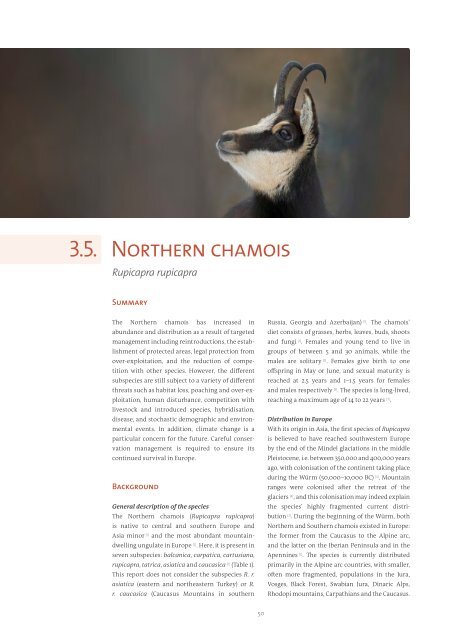130925-studie-wildlife-comeback-in-europe
You also want an ePaper? Increase the reach of your titles
YUMPU automatically turns print PDFs into web optimized ePapers that Google loves.
3.5. Northern chamois<br />
Rupicapra rupicapra<br />
Summary<br />
The Northern chamois has <strong>in</strong>creased <strong>in</strong><br />
abundance and distribution as a result of targeted<br />
management <strong>in</strong>clud<strong>in</strong>g re<strong>in</strong>troductions, the establishment<br />
of protected areas, legal protection from<br />
over-exploitation, and the reduction of competition<br />
with other species. However, the different<br />
subspecies are still subject to a variety of different<br />
threats such as habitat loss, poach<strong>in</strong>g and over-exploitation,<br />
human disturbance, competition with<br />
livestock and <strong>in</strong>troduced species, hybridisation,<br />
disease, and stochastic demographic and environmental<br />
events. In addition, climate change is a<br />
particular concern for the future. Careful conservation<br />
management is required to ensure its<br />
cont<strong>in</strong>ued survival <strong>in</strong> Europe.<br />
Background<br />
General description of the species<br />
The Northern chamois (Rupicapra rupicapra)<br />
is native to central and southern Europe and<br />
Asia m<strong>in</strong>or [1] and the most abundant mounta<strong>in</strong>dwell<strong>in</strong>g<br />
ungulate <strong>in</strong> Europe [2] . Here, it is present <strong>in</strong><br />
seven subspecies: balcanica, carpatica, cartusiana,<br />
rupicapra, tatrica, asiatica and caucasica [1] (Table 1).<br />
This report does not consider the subspecies R. r.<br />
asiatica (eastern and northeastern Turkey) or R.<br />
r. caucasica (Caucasus Mounta<strong>in</strong>s <strong>in</strong> southern<br />
Russia, Georgia and Azerbaijan) [1] . The chamois’<br />
diet consists of grasses, herbs, leaves, buds, shoots<br />
and fungi [1] . Females and young tend to live <strong>in</strong><br />
groups of between 5 and 30 animals, while the<br />
males are solitary [3] . Females give birth to one<br />
offspr<strong>in</strong>g <strong>in</strong> May or June, and sexual maturity is<br />
reached at 2.5 years and 1–1.5 years for females<br />
and males respectively [3] . The species is long-lived,<br />
reach<strong>in</strong>g a maximum age of 14 to 22 years [3] .<br />
Distribution <strong>in</strong> Europe<br />
With its orig<strong>in</strong> <strong>in</strong> Asia, the first species of Rupicapra<br />
is believed to have reached southwestern Europe<br />
by the end of the M<strong>in</strong>del glaciations <strong>in</strong> the middle<br />
Pleistocene, i.e. between 350,000 and 400,000 years<br />
ago, with colonisation of the cont<strong>in</strong>ent tak<strong>in</strong>g place<br />
dur<strong>in</strong>g the Würm (50,000–10,000 BC) [4] . Mounta<strong>in</strong><br />
ranges were colonised after the retreat of the<br />
glaciers [4] , and this colonisation may <strong>in</strong>deed expla<strong>in</strong><br />
the species’ highly fragmented current distribution<br />
[2] . Dur<strong>in</strong>g the beg<strong>in</strong>n<strong>in</strong>g of the Würm, both<br />
Northern and Southern chamois existed <strong>in</strong> Europe:<br />
the former from the Caucasus to the Alp<strong>in</strong>e arc,<br />
and the latter on the Iberian Pen<strong>in</strong>sula and <strong>in</strong> the<br />
Apenn<strong>in</strong>es [2] . The species is currently distributed<br />
primarily <strong>in</strong> the Alp<strong>in</strong>e arc countries, with smaller,<br />
often more fragmented, populations <strong>in</strong> the Jura,<br />
Vosges, Black Forest, Swabian Jura, D<strong>in</strong>aric Alps,<br />
Rhodopi mounta<strong>in</strong>s, Carpathians and the Caucasus.<br />
50


